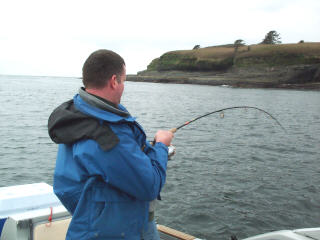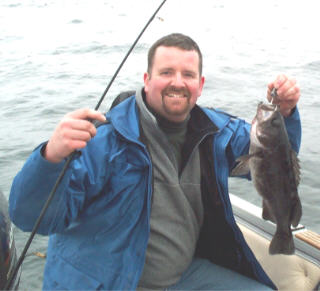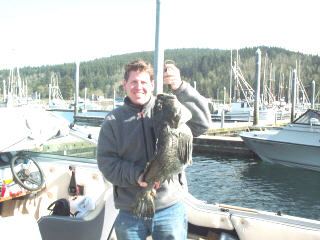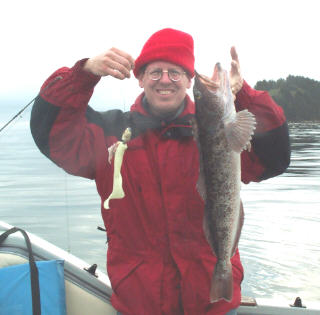Search
Latest Articles
Neah Bay - Washington's Bottomfish Capitol
by Mike Carey, April 21, 2002
April 21, 2002
Have the days of catching 2-4 pound sea bass one after another, non-stop for hours ended? The chance to catch a 25-35 pound ling cod in water under 100 feet - no more? A chance at exotic species like cabezon - gone? Not if you live in Washington and have a boat!
If it's April it must be time for all good salt water anglers to make the yearly trek to Neah Bay. Here you will find the bottom fish ready and willing to take anything you have to offer them. The fishing is, in a word, red hot. And now is the perfect time to dust off those 2 ounce jigs and curly tail plastics and get your fair share of some great tasting Neah Bay bottom fish. The ling season opened April 17th and the fishing has been great. Limits by those in the know, with plenty of just sub-legals to catch and release. And the sea bass? Can you say catch and release until you're too tired to catch and release any more? There are some huge schools of nice 2-4 pound sea bass, and catching these fish on light tackle will provide great sport.
My friend Carl and I headed west on Friday evening from Seattle, arriving at 8pm at the Snow Creek Resort. The weather was changing - for the better - and Saturday was looking to be nice indeed. Light winds, clear skies, and temps in the 50s greeted us. We had a site on the beach edge. Once you've driven 4 1/2 hours to get here, the scenery will remind you just why you took the trip. Jagged rocky cliffs, crashing sound of surf on the beach, screech of the sea gulls, sea lions snorting offshore - all these images and sounds, and more, quiet the mind and calm the spirit.
We launched at 7:30 am the next day. The water was reasonably calm with swells of just a few feet and very little wave action. I had a plan in mind. We turned west at Wadda Island and headed toward Tatoosh Island, about five miles away. Before we got to Tatoosh, we pulled up to some kelp beds along the rocky shoreline. I pulled out my light tackle and cast a one ounce jig with white/red tipped curly tail plastic toward the kelp. Almost instantly my jig was hammered by a solid fish. After a good fight, the 4 pound black sea bass came to the boat. Nice way to start the day! We fished this area for another 30 minutes or so. When you find one sea bass, you'll usually find more as they are a schooling fish. Strangely, this was the only one we hit here. As we fished a gray whale surface about 300 yards from us, it's blow hole spouting water into the air. What a sight! We moved the last mile and a half to Tatoosh island. There was one other boat out there with us. Once again we began casting our jigs, usually retrieving them as soon as they hit the water, although sometimes I would do a ten count and then retrieve it. We immediately found the sea bass and they were hungry. Carl and I began catching fish after fish. It seemed that we had found a huge school of the aggressive black sea bass. We tried different plastic shapes and colors. Everything we threw at them seemed to work - light, dark, they all caught fish. We caught and released dozens of sea bass, keeping a few of the bigger fish. It went on this way from 9 to 11 am. At 11 am I decided it was time to put in some work for something a little bigger - the ling cod.


And... a typical bass.
Ling Cod are big, bad, and ugly. And they taste great. Which are good reasons to fish for them, but an even better reason is they put up a fight to rival the best fighting fish in Washington. This year the size limit is a minimum of 24 inches. That will give you two good sized fillets for your frig. There are several ways to catch these fish, but the most important thing is you need the bait on the bottom. So look for days that don't have big tide swings, or fish the tide changes. Adjust the weight of your lure to account for the tides and wind drift. The nice thing about fishing for lings in the spring is that the big ones tend to come in to the shallows. We fished 45-95 feet during the trip, as did the most successful anglers at the cleaning stations. Time of day? I didn't notice much variation in fishing success from mid-morning to early afternoon. The action was better at the tide change. This makes sense as the lings move out of their rocky homes in search of easy prey. For gear, I used a stout jigging rod with a level wind reel, 5:1 retrieve, and 50 pound "Tuff line". My terminal gear included a barrel swivel, 36 inches of leader, and either a 2-4 ounce lead jig with large curly tail plastic, or, a 6-8 ounce jigging lure. I also added a strip of squid meat to the jig for some flavor enhancement. Old pros like to send down live kelp greenlings as bait. The larger lings will clamp on to these bait fish and you just pull them to the surface. That's where having a good man at the net is important because these fish are not hooked, they are just hanging on for the ride. So the netter needs to scoop before the ling lets go. It's very important to not let the lings head come out of the water or it will let go.
I began banging the bottom along the same drift that we had been catching the sea bass. I would feel the jig hit the rocky bottom and then bring it up 2-3 feet. Don't use a big sweeping jerk. A smooth, slow jig motion works just fine. I brought up several sub-legal fish from 45-65 feet deep. At high noon my rod tip jerked violently down. I set the hook and began bringing up what felt to be a good sized fish. Lings fight like bulldogs. They don't run like salmon, rather, they head shake, pull short runs of great strength, and generally try to jerk the pole out of your hands. Hang on tight! As the fish came to the surface Carl reached the net down to bring in the fish. It was a nice keeper, I'm guessing ten pounds or so of mad ling cod. The net went in - no! The hook was on the lip of the fish and as the net went in the hook came out. I watched in dismay as my keeper descended back to the bottom for some other lucky angler to catch. It's hard to stay bummed for too long when you are in a place as beautiful as Neah Bay. Besides, there are plenty more where that one came from.
We had enough of Tatoosh island and worked our way back to Neah Bay. Around 2 pm we began fishing the northwest side of Wadda island, which is the island that anchors the breakwater and is the entrance to Neah Bay. There were several boats fishing in this spot. We started a drift in the 55-85 foot range, working from shallow to deep water. Jigs on the bottom for both of us. It didn't take long before I called out "fish on!". And this time it was a big one. My rod tip was buried into the water several times as I fought this fish. When it came to the net I was rewarded for my efforts with a monster of a cabezon. A cabezon is a bottom fish that feeds primarily on shrimp. This one had been doing a lot of feeding over the years. That was it for the day and we headed in.

Sunday was more of the same. This time we concentrated our efforts around Wadda island and Seal Rock. Seal Rock is a prominent rock formation located about three miles east of the Neah Bay marina. This area has good populations of sea bass, rockfish, and lings. It is also hit harder due to it being better sheltered from the west winds. This is the spot anglers with 12-16 foot boats will head to when the waves are too strong around the west side of Wadda island. You'll be once again fishing 45-95 feet for lings. For the sea bass and other bottom fish, head in toward the kelp beds. Lings can be found here as well. Most of them will be sub-legal, but once in awhile you'll hook a keeper. We ended our trip catching quite a few twenty inch lings in this area, as well as the numerous sea bass. The high point of Sunday for me was the one that got away. Another large ling that hit my jig hard. I brought it up about 5-10 feet and it promptly turned and drove back to the safety of the rocky bottom, into a hole which I was unable to budge it out of.

If this kind of fishing sounds like what you're looking for then now is the time to go. Spring bottom fishing at Neah Bay isn't as crowded as the salmon seasons that occurs later in the summer, and the weather can cooperate for some very pleasant days. The bottom fishing should hold up well for several more weeks, just in time for halibut opener in May. But that's another fishing trip



